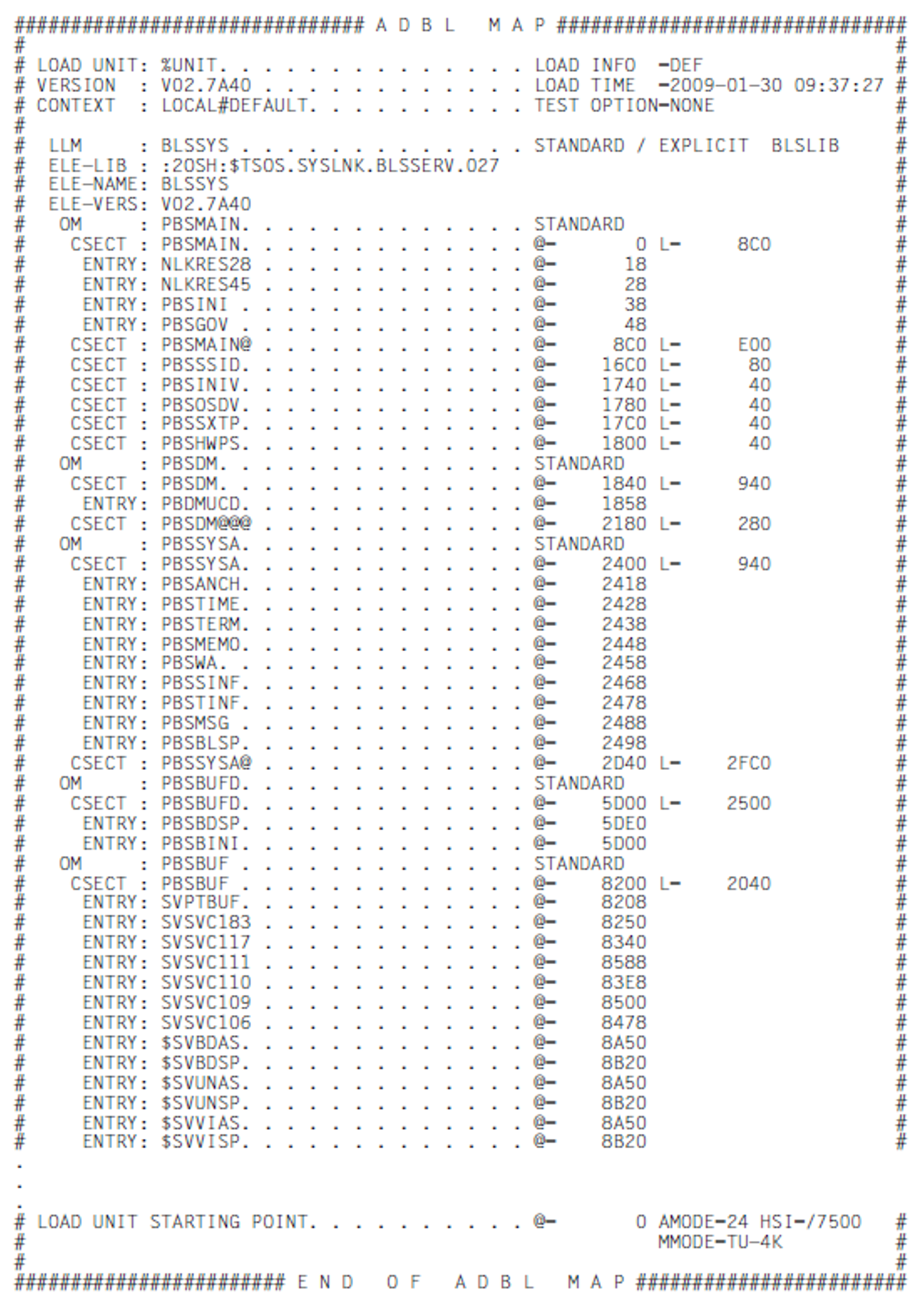A DBL map containing information about the structure and contents of the loaded load unit is output when the PROGRAM-MAP operand is included in the load call with a command or the MAP operand in the BIND macro. Output of a DBL map is possible only in the ADVANCED operating mode (see "Migration from the dynamic linking loader DLL to DBL"). The SYSOUT or SYSLST system file, or both, may be selected as the output destination. The BIND macro also offers the option of output to a user-defined data area.
The following table provides an overview of the information output for a load unit and the loaded modules.
Information | Object | |||||||||
A | B | C | D | E | F | G | H | I | ||
Object name | X | X | X | X | X | X | X | X | X | |
Name of the | X | |||||||||
Load information | 1) | X | ||||||||
Type of LLM / | 2) | X | X | |||||||
Type of OM | 3) | X | X | |||||||
Object address | X | X | X | |||||||
Object size | X | X | X | |||||||
Linkage method | 4) | X | X | X | ||||||
File link name | 5) | X | X | X | ||||||
Library/ file | 6) | X | X | X | ||||||
Element name | X | |||||||||
Element version | X | |||||||||
A | Load unit |
B | LLM |
C | PAM-LLM |
D | OM in LLM |
E | OM |
F | CSECT |
G | ENTRY |
H | COMMON |
I | XDSEC-D |
Footnotes
The following load information is output:
Value of the LOAD-INFORMATION operand
Program version of the load unit. If no program version was specified in the load call, DBL shows the PLAM version of the loaded library member (~ stands for the highest PLAM version)
Load time
Value of the TEST-OPTIONS operand
Start address of the load unit (load unit starting point)
Addressing mode (AMODE):
24, 31 or 32as the code type for HSI=:
/7500
The symbol from the load call indicates /390 code
/4000
The symbol from the load call indicates RISC(MIPS) code
/SP04
The symbol from the load call indicates SPARC code
/X86
The symbol from the load call indicates X86 code
The type of LLM/PAM-LLM (see the manual “BINDER” [1]) is output as follows:
STANDARD
The LLM consists of a single slice.
BY-USER
The LLM consists of user-defined slices.
BY-ATTR
The LLM consists of slices formed by attributes.
The type of OM is output as:
STANDARD
The OM was generated by a compiler.
PRELINK
The OM was generated as a prelinked module in a TSOSLNK linkage run.
The bind (linkage) method is output as:
EXPLICIT
The module was loaded as primary input through an explicit specification in the load call.
AUTOLINK
The module was loaded as secondary input by means of the autolink function in order to resolve external references.
INCLUDE
The module was loaded as secondary input as a result of INCLUDE statements inserted in already loaded modules. This is only possible for object modules (OMs).
PUBLIC
An LLM consists of slices formed according to the PUBLIC attribute (see the “BINDER” manual [1]). When the LLM was loaded, the slices were loaded with the PUBLIC attribute into class 6 memory.
The file link name of the library in which the LLM/OM was found is output. If a user or system Tasklib is concerned, USERTSKL or SYSTTSKL is output. ECERDLOD is output for PAM-LLMs.
Example of a DBL map (extract)
Layout of the DBL map in a user-defined data area
BIND ...,USRMAPI=...,USRMAP@=...,USRMAPL=... (where USRMAPIîNONE) enables a DBL map to be output to a user-defined data area. This map is structured in a similar way to the list output to SYSOUT/SYSLST. It has the following layout:
Map header for identifying the area
This contains the return code X’08010129’ if the length of the data area is not sufficient to contain the required information.
The layout of the list header depends on the INTVERS specification in the BIND macro: INTVERS=SRV005 generates a list header version 1, INTVERS=SRV006 generates a list header version 2. This shows whether the library name, element name and element version are contained in the information output.Total length of the information output, including map header
Data records with the following layout:
Record ID
Length of the information contained in the record
The information itself
In the case of INTVERS=SRV005 the user-defined data area must be at least 248 bytes long, and in the case of INTVERS=SRV006 at least 336 bytes long to accommodate the minimum information.
If the length of the data area is not sufficient to contain the required information, output is aborted.
If the length of the data area is sufficient, the output is terminated by an end record.
The layout of the data area can be generated with
BIND MF=D,XPAND=USRMAP,INTVERS=SRVxxx (xxx >= 005).

